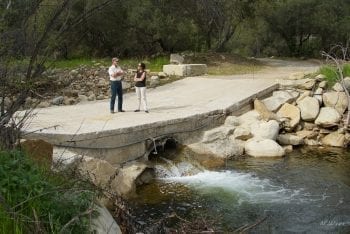The elusive Southern California steelhead is an incredibly resilient species. Their genetic diversity has, so far, enabled them to adapt to higher water temperatures (up to 77°F!), low streamflows, and weather variability. Southern steelhead are the fish of the future. Their amazing resiliency is a major reason why we need to protect this distinct species. Sustaining their genetic diversity is crucial as it may offer clues that could help other steelhead populations further north weather hotter water with a warming climate.

Photo by Mark Capelli.
Southern steelhead historically populated all coastal streams of southern California with permanent flows. As more and more people moved into coastal areas to take advantage of the great weather and recreational activities, Southern steelhead became excluded from their historic range, eventually leading to their listing as an Endangered Species in 1997. The 2017 SOS II: Fish in Hot Water report released by California Trout and UC Davis Center for Watershed Sciences found the Southern steelhead to be at a critical Level of Concern, meaning they could go extinct within 50 years if we don’t change course.
They have survived against all odds. What little is left of their habitat has been urbanized and degraded through engineering and land use practices that did not consider the need for steelhead passage and headwaters residence. Barriers– dams, bridges, and other in-stream structures– block and hinder steelhead access to headwater spawning and rearing tributaries upstream and also restrict the emigration of juveniles to the ocean. Estuaries and lagoons, which are critical nursery habitats and important transition zones, have been significantly reduced in size and function due to human activities.
For Southern Steelhead to continue their survival in the extreme southern end of their range, while sharing their home with 22 million Southern Californians, careful human intervention is required. To recover this species, California Trout leads two Coalitions, the Santa Clara River Steelhead Coalition (serving Ventura and Los Angeles counties) and the South Coast Steelhead Coalition (San Diego and Orange counties). We work with Coalition partners– non-profits, government agencies, tribes, and interested stakeholders– to re-establish steelhead populations in high priority watersheds.

Assessing a concrete fish passage barrier on Santa Paula Creek. Photo by Mike Wier.

Removing invasive species that eat juvenile steelhead from Santa Margarita River. Photo by Sandra Jacobson.
This is done by restoring estuaries, which are critical nursery areas and transition zones, in addition to riverine habitat, much of which has become degraded, over-run with invasive species, and low on water flows. Removing in-stream barriers is another a key part of our steelhead recovery plan since fish passage among the complex array of concrete infrastructure is a major concern.
CalTrout’s headwaters-to-ocean recovery approach will ensure the long-term persistence of self-sustaining wild populations of Southern steelhead.
The Southern steelhead were featured in the Summer 2017 issue of the Current – click here to read.
Learn more about our plan to save California’s remaining native salmon from SOS II: Fish in Hot Water.
More Fish of the Month features:




